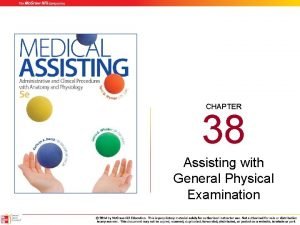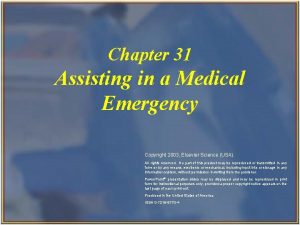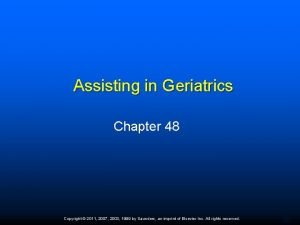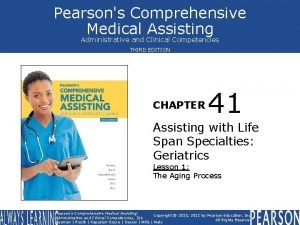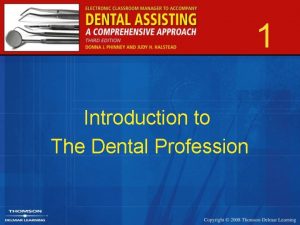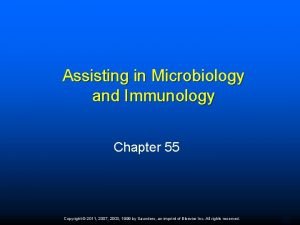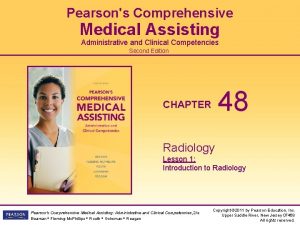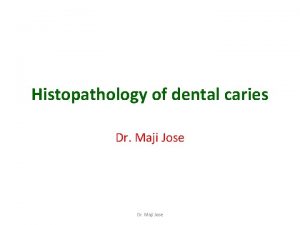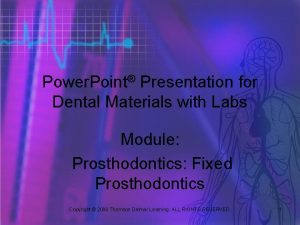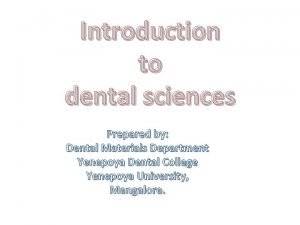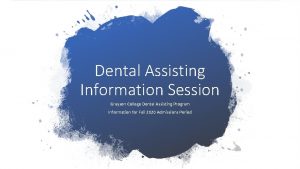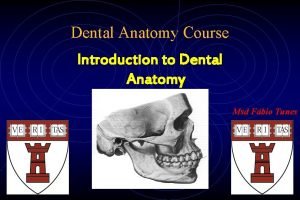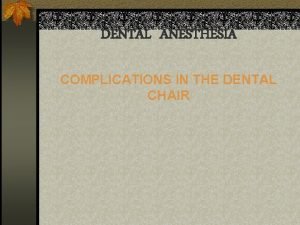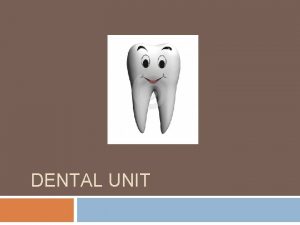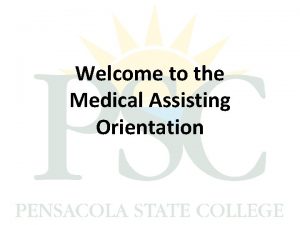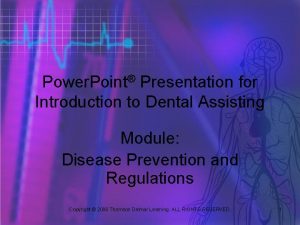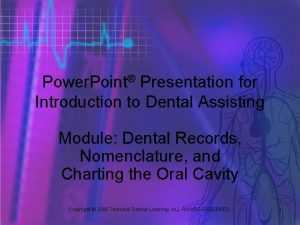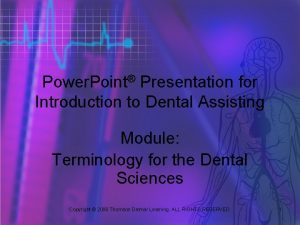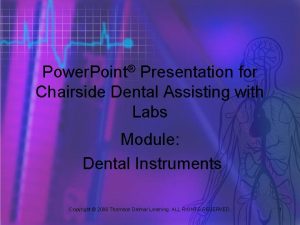Dental Assisting Chapter 6 General Anatomy Introduction Anatomy






















- Slides: 22

Dental Assisting Chapter 6, General Anatomy

Introduction Anatomy is the scientific study of the shape and structure of the human body It is important for the dental assistant, as a healthcare professional, to understand the basic structure and shape of the human body Anatomical terms must be understood for communication in the health professions to be effective

General Anatomy Basic anatomical reference systems Planes and body directions Structural units Body cavities Body regions

Planes and Body Directions Anatomical position is the body standing erect with the feet together and the arms hanging at the sides with the palms facing forward

Planes and Body Directions (Cont. ) The sagittal plane is a vertical plane dividing the body from top to bottom and into left and right sections The midsagittal plane is vertical, dividing the body into equal left and right halves The horizontal plane divides the body into superior (upper) and inferior (lower) portions The frontal plane divides the body into anterior (front) and posterior (back) portions

Structural Units Cells Tissues Organs Body systems

Organizational Levels of the Body

Cells, the basic units of structure in the human body, react to stimuli, transform nutrients into energy, grow, and reproduce The term for specialization of cells is differentiation The human body contains many types of cells, each with a purpose

Basic Human Cell

Stem Cells Immature, unspecialized cells in the body Can be induced to become other types of cells in the body There are two primary sources of stem cells Embryonic stem cells Adult stem cells

Embryonic Stem Cells Come from embryos that develop from eggs that have been fertilized in a test tube and then are used for research purposes They are not derived from eggs fertilized in a woman’s body Currently there are no approved treatments or human trials using embryonic stem cells in the United States

Adult Stem Cells Can be found in tissues of both adults and children Stem cells from bone marrow have been used in bone marrow transplant procedures for many years Adult stem cells are also found in blood, skin, dental pulp, retina, skeletal muscle, and the brain

Cell Membrane The cell membrane surrounds the cell body and serves two purposes: Structural: separates the contents of the cell from the surrounding environment Semipermeable: allows nutrients to pass through and waste products to leave

Cytoplasm It is a gelatinous fluid inside the cell It contains organelles Organelles modify, store, and transport proteins and dispose of cellular wastes

Nucleus The control center of the cell Directs the metabolic activities of the cell The nucleus of every cell (except mature red blood cells) contains a complete set of the body’s chromosomes The chromosomes contain DNA and RNA, two chemicals that carry all genetic information

Tissues Formed when many millions of cells with the same shape, size, structure, and function join together to perform a specific function for the body

Types of Tissues Epithelial tissues are external (skin) or internal body surfaces (mouth, intestines, and so on) Connective tissue includes fat, tendons, and ligaments Muscle tissue Voluntary (e. g. , arms, legs) Involuntary (e. g. , heart, lungs, stomach) Nerve tissue includes the brain, spinal cord, and nerves

Organs are formed when several types of tissues become a group Organs perform a single function Organs contain each of the four tissue types: Nerve Connective Muscle Epithelial

Body Systems A body system is composed of a group of organs working together to perform a major function Example: The digestive system Esophagus Stomach Small and large intestines

Body Cavities The two main body cavities Dorsal: Back of the body Divided into the cranial cavity and the spinal cavity Ventral: Front of the body Subdivided into the thoracic cavity and the abdominopelvic cavity The thoracic cavity contains the heart, lungs, esophagus, and trachea The abdominal cavity houses the stomach, liver, gallbladder, spleen, and most of the intestines The pelvic cavity contains portions of the small and large intestines, the rectum, the urinary bladder, and internal reproductive organs

Body Cavities

Body Regions Axial division: Head, neck, and trunk Appendicular region: Arms and legs Because of the relationship between disease and anatomy, methods of seeing into the body have become a mainstay of the diagnosis and treatment of disease.
 Chapter 6 general anatomy
Chapter 6 general anatomy Chapter 2 dental assisting
Chapter 2 dental assisting Assisting with a general physical examination
Assisting with a general physical examination Chapter 42 assisting in other medical specialties
Chapter 42 assisting in other medical specialties Chapter 5 assisting with the nursing process
Chapter 5 assisting with the nursing process Chapter 31 assisting in a medical emergency
Chapter 31 assisting in a medical emergency Chapter 41 assisting in geriatrics
Chapter 41 assisting in geriatrics Chapter 41 assisting in geriatrics
Chapter 41 assisting in geriatrics Chapter 42 assisting in other medical specialties
Chapter 42 assisting in other medical specialties Robert woofendale
Robert woofendale Medical assistant program rop
Medical assistant program rop Guest arrival and departure procedure
Guest arrival and departure procedure Noun form of advertise
Noun form of advertise Assisting in microbiology and immunology
Assisting in microbiology and immunology Pearson comprehensive medical assisting
Pearson comprehensive medical assisting Chapter 6 general anatomy and physiology
Chapter 6 general anatomy and physiology Bacterial colonies
Bacterial colonies Waistline
Waistline Medial and lateral
Medial and lateral 2012 pearson education inc anatomy and physiology
2012 pearson education inc anatomy and physiology Impression materials in dentistry ppt
Impression materials in dentistry ppt Introduction to dental materials
Introduction to dental materials Diferencia entre gran plano general y plano general
Diferencia entre gran plano general y plano general


